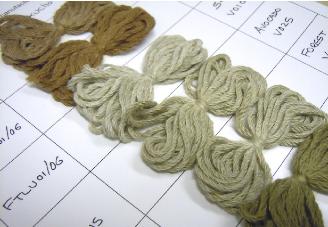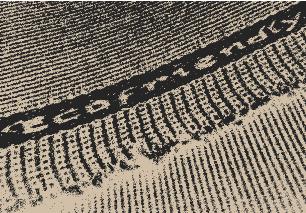 |
 |
 |
||
Ginning is the generic term used to describe the complete process of turning the cotton bolls into fibre prior to spinning which is another generic term for all the processes the fibres passes through to become yarn, ready for eventual weaving or knitting. Cotton is a very important global commodity, however many farmers in the developing world are paid very little for their produce. They find it difficult to compete with the developed countries especially when government subsidies artificially depress the global price of cotton. The increasing demand for cotton at competitive prices has resulted in what may be considered exploitation of poor cotton farmers and the land upon which it is cultivated. To grow more profitable crops the wide use of chemicals is standard practice within the greater majority of the industry, making cotton the most pesticide dependent global crop. The use of pesticides accounts for more than 50% of the total cost of cotton production in most of the world. According to the WHO (World Health Organisation) cotton consumes around 25% of the world’s output of pesticides. Many deaths each year in the developing world are linked to pesticide poising, many of which are related to cotton farming. There are about 30 species of insects that attack cotton ensuring that for commercial production insecticides and artificial fertilizers are all too prevalent in cotton agriculture. Cotton is also notoriously thirsty crop, which presents problems to those countries whose economic growth relies upon the cotton industry, as often their geographical position tends to be in areas suffering from water shortages. The shrinking of the Aral Sea is an ecological disaster attributed to the intensive irrigation of cotton crops. Once the fourth largest lake in the world, it has shrunk by 70% in recent decades. Uzbekistan and Kazakhstan, both once part of the old Soviet Union, have in parts been turned into a desert through the excessive cultivation of cotton. Approximately 30% of the cotton harvested and knitted for t-shirt production is then shipped to a second country for manufacturing, impacting on cotton’s carbon footprint.
Organic Cotton There are a growing number of farmers moving towards a more organic, ecologically sound and socially sustainable method of production. Organic agricultural methods rely upon crop rotation and the use of natural enemies, such as lady beetles to suppress harmful insects rather than the use of agrochemicals, artificial fertilizers and other toxic chemicals. Organic cotton does not use genetically modified organisms but seeks to build a biologically diverse agricultural system, replenishing and maintaining soil fertility. Organic cotton is far more expensive to produce, however it does not pollute and there is no over production. Turkey is the primary producer of organic cotton. Other producers include the United States, India, Peru, Uganda, Egypt, Senegal, Tanzania, China and Israel. Organic cotton currently accounts for 1% of the total cotton market.
Low Water Use Cotton Minimising water usage in cotton growing is a key concern, as around 50% of all cotton is irrigated. Currently about 99% of West African cotton is rain fed, as is a large proportion of Indian cotton. The draw back to rain fed cotton is that it tends to be of a lower quality due to the reliance on sporadic rainfall. There are also more efficient irrigation techniques available (such as drip irrigation, which can save up to 30% of the water needed for conventional irrigation). The technique is labour intensive and only suitable for areas where hand picking is the harvesting method, as the irrigation lines need to be laid by hand, and machine harvesting would rip up the irrigation lines.
Naturally Coloured Cotton The cultivation of Peruvian Pima and Tangüis cotton is naturally pigmented in a range of beiges, rusts, browns and greens coloured and grown organically. The fibres have some limitations due to fineness and a relatively short staple length, but offer niche markets the benefits of unique and authentic colour, with no need for dyeing processes. Peru Naturtex partners is an organisation that offers local Peruvian farmers a lucrative cash crop as an alternative to growing coca. In the U.S Fox fibre produces naturally coloured cotton also in a range of brown, green and rust shades. Most of their crops are organically grown in Texas, New Mexico and Arizona. Naturally coloured cotton has the advantage of needing minimal maintenance after sowing and is far more resistant to pests, and so does not require fertilizers and pesticides. Naturally coloured varieties need far less water during the growing cycle and can thrive successfully in quite arid soils. Naturally coloured cotton has inbuilt fire retardant properties. It has recently been discovered that the cotton seeds also contain significant amounts of natural antibiotic substances.
Fair Trade Cotton Fair trade cotton is defined as; cotton which has met the international fair trade standard for the production of seed cotton (as harvested with seed and fibre attached) and is therefore eligible to carry the FAIRTRADE mark. It is an independent product certification label that guarantees the farmers are getting a fair and stable market price, as well as benefiting from longer term and more direct trading relationships. Cotton farmers are at the bottom of the supply chain and therefore susceptible to price exploitation within the trading system. The Fair-trade certification helps to redress the situation by setting the price at farm gate level and basing it on the actual cost of sustainable production. If the market price is higher than the minimum then the market price applies. FAIRTRADE clothing is not to be confused with ethical trading as they are different things. Ethical trading or sourcing is a business model that aims to ensure that acceptable minimum labour standards are met in the supply chain for the whole company and their range of products. FAIRTRADE specifically aims to improve marginalised producers in the developing world and to contribute sustainable development that have a wider community benefit. FAIRTRADE cotton and organic cotton are not part of the same criteria, at present only about 20% of the FAIRTRADE cotton producers are farming organically, although those that are not organic producers must implement a system of integrated crop management to establish a balance between environmental protection and business results. Organic fertilisers and biological disease control methods are progressively used to replace traditional methods of farming, this gradual process mitigates the drop in yield and financial loss that occurs with organic conversion. The FAIRTRADE standards prohibit the use of genetically modified seeds as well as encouraging appropriate water management. (source ICAC 2004)
The American and Australian cotton industries have invested in biotechnology to try to combat the excessive use of insecticides associated with standard commercial cotton production. This has been done through the controversial use of biotechnology resulting almost a quarter of global cotton production today being Genetically Modified cotton. There are two types of transgenic cotton in use: Bollgard ® is obtained from a naturally occurring soil bacterium, Bacillus thuringiensis and referred to as Bt cotton. Used as a spray it reduces the use of insecticides by up to 85% compared to conventionally grown cotton. It gives the plant an in-built tolerance to its main pest, the Heliothis caterpillar and, in North America the Boll Weevil. The alternative product is Roundup Ready ® which is obtained from the soil bacterium Agrobacterium tumefaciens. This herbicide tolerant cotton reduces the amount of soil cultivation and herbicides needed on crops to control weeds. It also supposedly promotes healthier soil through less disruption and a reduction in herbicide residues. The Sustainable Cotton Project in California has championed biological IPM (integrated pest management) techniques through the BASIC (biological agricultural systems in cotton) programme. It claims that in recent years the BASIC growers have reduced the use of pesticides by up to 70% consistently over several growing seasons. |
COTTON
 PROCESSING
PROCESSING

 Biotechnology
Biotechnology 